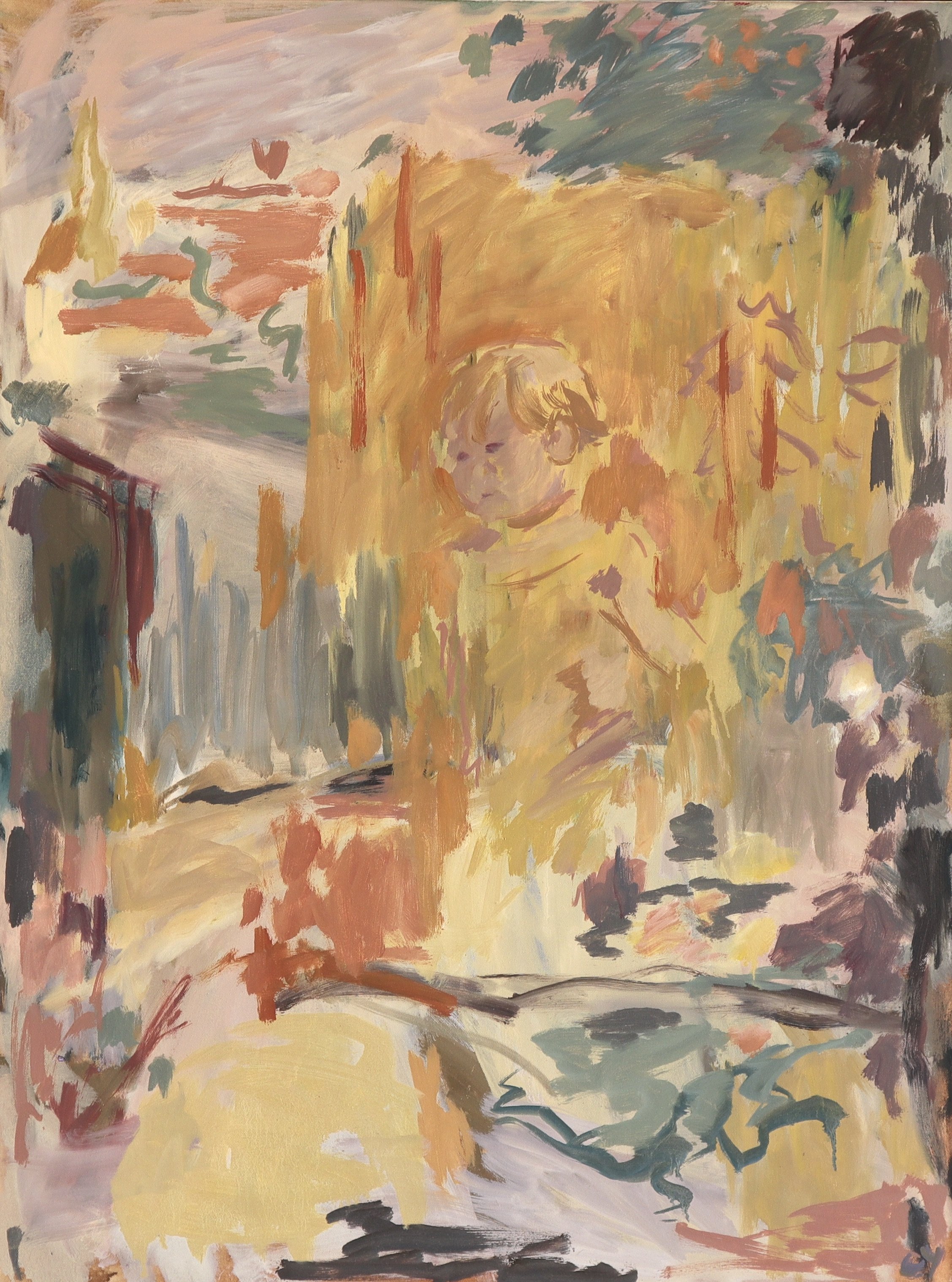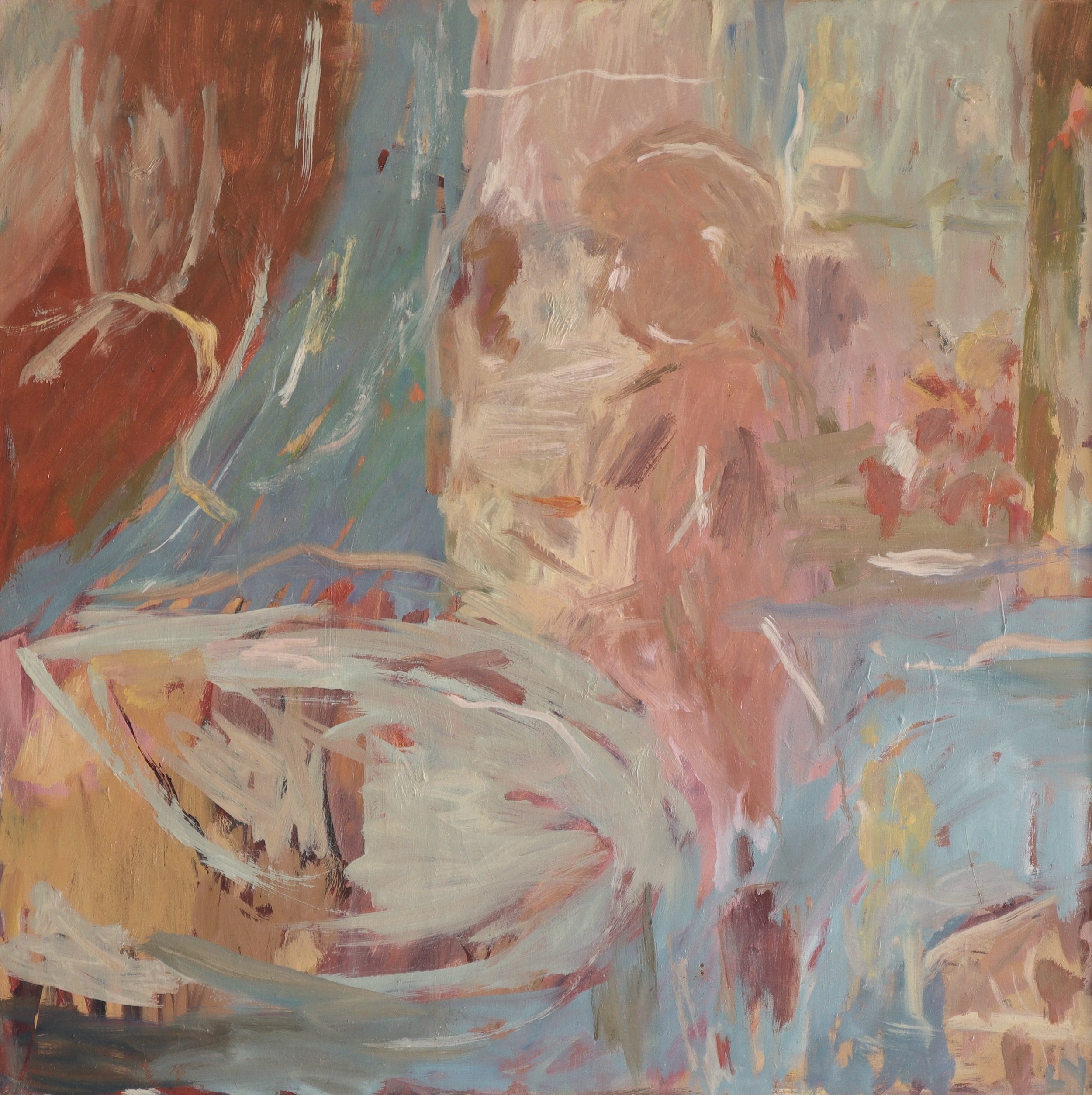
Courtney is an emerging artist and regenerative farmer with a background in environmental restoration. Through her art practice, Courtney is interested in unpicking what it means to be a white woman and mother living and working in the Australian landscape. Her borderline abstract paintings challenge prevailing colonial approaches to understanding the landscape and question outdated wild/domestic, native/invasive dichotomies.

Hey Courtney! To start, can you tell me a bit about how your artistic journey began?
I’ve been interested in art for as long as I can remember but the catalyst for me to start taking my art practice more seriously was the birth of my daughter nearly five years ago.
You grew up on Yulin country on the south coast of NSW, how has growing up here affected your artistic practice?
The south coast is such a rich and beautiful region and I think it instilled in me an appreciation for the environment that influences all aspects of my life and work. During high school, I was lucky to be surrounded by quite a creative and progressive bunch of friends and wider community. I think it helped me imagine what different ways of making a life might look like. But as with growing up in any small rural community, it felt suffocating at times and I was riddled with insecurity like a lot of young people. I felt very much overwhelmed when I moved away to go to uni. And so that took a while for me to shake off before I could really commit to my art practice.
More directly though, I think colour, layers and texture are pretty important in my work, and maybe this comes from living in the diverse landscape of the south coast. I grew up playing in the bushland beside our house and that feeling of being encompassed by the bush is something I find myself looking for when I’m painting.
You have a background in environmental restoration and regenerative agriculture and you’re also the founder of a successful organic flour business, Woodstock Flour. How has your experience as an organic farmer influenced your artistic practice, or vice versa?
I think starting a business with my partner definitely gave me the confidence to pursue painting more seriously. We’ve been quite lucky, and we’re also super privileged as white people connected to a multi generational family farm. But it’s been so reaffirming to build a business that’s aligned with our values and see it resonate with other people. And making something real (in our case, flour) to go out in the world is such a rewarding way to work.
It sounds really boring, but I think starting our business has taught me the value of discipline, finding/building a community and not being afraid to show and talk about my work. Marketing, presentation and relationships are just as important as actually making the work. And trusting that if I make work that is genuine and in line with my values, people will connect with it.Farming is a whole other ball game and something we’re quite new to, having only just bought our own property. With farming you’re trying to manage so many different factors that are outside of your control. So for us we’re trying to stay on top of things by constantly monitoring and trying to work with not against the environment we’re in. And I think this mindset crosses over to painting- constant looking and going with what the painting needs not what I want for it. Being outside and active, working with animals, and watching life grow (and decay) is also so humbling and inspiring.

Who and what do you consider as your biggest artistic influences?
So many contemporary artists come to mind but I guess at the moment I’m really drawn to the work of Sally Anderson and Amber Wallis. They’re both amazing Australian painters who merge interiors with landscapes, and abstraction with figuration. They’re also both mothers of young children which I feel must influence their subject matter, and might be part of the reason I’m so drawn to their work.
What connection does the medium of painting and your abstract style hold with the themes explored in your work?
I’ve always loved colour and the materiality of paint. And I think the way you can create depth and evoke some sort of feeling or atmosphere through paint on a 2D surface is really amazing. I’m interested in the way people relate to land, interior spaces and each other on a conceptual and visual level, and I think painting, with elements of abstraction, is a great vehicle for this. There are so many relationships playing out on the canvas- between colours, shapes, line, etc. Each part is understood in relation to the other parts. And I think this is similar to the relationships that are happening outside of the canvas. I feel that abstraction, along with elements of representation, can speak to the imagined boundaries we draw between people and land by breaking them apart, and merging things that we don’t at first think merge together. Our eyes want to make sense of what we see and so when there’s something representational in a largely abstract piece, our mind starts playing games. Asking myself (and in turn the viewer) to sit with this tension is really interesting.
Many of your works feature children and your current exhibition at Art Gallery on Ovens in Wangaratta is called The Cradle. What do you seek to express about motherhood and childhood in your work?
This is my first solo show and so I wanted to make work that reflects the formative stage of life I’m in- raising two little kids! Before having kids, I’d always wanted to pursue art but had never had the confidence. Growing a little human broke me open in so many ways. I felt I could effectively start again and do what I’ve always wanted to do. I also wanted to set an example for my daughter by building a creative and meaningful life for myself and our family.
In the series The Cradle, I was looking at the work of Berthe Morisot, a 19th century French impressionist who I loved as a kid. Looking at her work now, I’m drawn to the way she paints motherhood and children, sometimes with joy and curiosity and other times with ambivalence, boredom and even despair. I also love the way she paints figures in the landscape or in threshold spaces like windows or doorways. I used Morisot’s work as an entry point for the subject matter and composition of many of my paintings, trying to recontextualise her work to suit my experience of motherhood and how I relate to my kids, our home and the landscape we’re in. I guess I’m trying to tap into the transience and complexity of parenting and of human relationships.

What are your artistic goals for the future? Do you see your work taking on new forms or directions?
This year I’m trying to focus more on process rather than outcome, bringing my practice back to basics through drawing and writing. I’d like to continue exploring that murky line between abstraction and representation, and seeing where figures and still lifes can fit in.
Conceptually, I’m also really keen to start looking at whiteness in my work. I live in a rural area and I’m part of a farming community that is very white and very privileged. I want to investigate my own whiteness and complicity in a culture that marginalises First Nations People and people of colour. I’m also interested in whiteness in terms of land management and how land ownership intersects with class and race. I’m not sure what this will look like yet, but, again, I’m trying to focus on the process.
Interview by Sarah Walliss




